Metamorphosis |
||||||||||||||||
 |
 |
|||||||||||||||
Knitted jumper in DROPS Air and DROPS Big Delight. Piece is knitted top down in two coloured English rib with raglan. Size: S - XXXL
DROPS 215-22 |
||||||||||||||||
|
------------------------------------------------------- EXPLANATION FOR THE PATTERN: ------------------------------------------------------- PATTERN: See diagram A.1. All uneven rounds are worked with Big Delight. All even rounds are worked with Air (see diagram). INCREASE FOR RAGLAN: Increase for raglan on each side of purl stitches with marker (= raglan stitches), i.e. Increase in knit stitch and yarn over closes raglan stitch. Increase 2 stitches on each side of raglan stitches (= 16 stitches increased on increase round): All increases are done on a round where yarn over and knit stitch are knitted together (= a round with Air). Increase 2 stitches in knit stitch and yarn over by working 3 stitches in stitch and yarn over as follows: Knit stitch and yarn over together but wait to pass stitch and yarn over off left needle, make 1 yarn over on right needle, knit same stitch and yarn over together one more time, then slip knit stitch and yarn over worked off left needle (= 2 stitches increased). Then work the new stitches in English rib (A.1) but note that on first round after increases, purl purl stitches in increase without working together with yarn over because yarn over is not made. DECREASE TIP (applies to mid under sleeves): Decrease under sleeves on each side of 3 stitches mid under sleeve (= 1 purl stitch + 1 English rib stitch (= stitch with marker) + 1 purl stitch). All decreases are done on a round where yarn over and knit stitch are knitted together (= a round worked with Air). DECREASE 2 STITCHES TOWARDS THE LEFT AS FOLLOWS (i.e. begin right after first purl stitch after stitch with marker): Slip first knit stitch and yarn over on to right needle knitwise, knit the next 2 stitches together (i.e. 1 purl + knit stitch and yarn over), then slip the loose stitch and yarn over over stitches worked together (= 2 stitches decreased). DECREASE 2 STITCHES TOWARDS THE RIGHT AS FOLLOWS (i.e. begin 4 stitches + 2 yarn overs before stitch with marker): Slip first knit stitch and yarn over loosely on to right needle knitwise, purl 1, pass slipped stitch and yarn over over purl stitch, slip stitch back on left needle, pass slipped stitch and yarn over closest to purl stitch over stitch place back on left needle, slip the remaining stitch over on to right needle (= 2 stitches decreased). CAST-OFF TIP: To avoid a tight cast-off edge you may use a larger needle size. If this also is too tight, work a 1 yarn over after approx. every 4th stitch while casting off (cast off yarn overs as regular stitches). ------------------------------------------------------- START THE PIECE HERE: ------------------------------------------------------- JUMPER - SHORT OVERVIEW OF THE PIECE: Neck edge and yoke are worked in the round on circular needle, top down. Now divide yoke for body and sleeves. Body is worked in the round on circular needle, top down. Work sleeves in the round on double pointed needles/short circular needle, top down. Work yoke, body and sleeves in two-coloured English rib with Air visible on right side and Big Delight visible on wrong side. Turn piece inside out when finished (before assembly) so that Big Delight is visible on right side. Work neck edge and rib at the bottom of sleeves and body with Air. NOTE! All numbers of given when working English rib is without yarn overs because yarn overs are counted as 1 stitch together with slipped stitch. NECK EDGE: Cast on 78-82-86-88-96-100 stitches on a short circular needle size 4 mm with 1 strand Air. Rounds begin mid back. Knit 1 round. Then work rib in the round (= knit 1/purl 1) for 8 cm. Knit 1 round while decreasing 2-2-6-4-0-0 stitches evenly = 76-80-80-84-96-100 stitches. Insert 1 marker in middle of round. Then work yoke as explained below. Measure yoke from marker. YOKE: Switch to circular needle size 5 mm and knit 1 round. Work next round as follows: * Knit 1, make 1 yarn over, slip 1 stitch purlwise *, work from *-* the entire round. Now insert 4 markers in piece as explained below (this is done without working the stitches). Use markers when increasing for raglan. Count 13-15-15-15-17-17 stitches (= half back piece), insert 1 marker in next stitch (= raglan stitch), count 9-9-9-9-13-13 stitches (= sleeve), insert 1 marker in next stitch (= raglan stitch), count 27-29-29-31-33-35 stitches (= front piece), insert 1 marker in next stitch (= raglan stitch), count 9-9-9-9-13-13 stitches (= sleeve), insert 1 marker in next stitch (= raglan stitch). 14-14-14-16-16-18 stitches remain on back piece after last marker. Then work A.1 in the round, every other round with Air/Big Delight. AT THE SAME TIME increase for RAGLAN as explained below. REMEMBER THE KNITTING TENSION! RAGLAN: When 7 rounds of A.1 have been worked in total (and next round begins with “knit yarn over and slipped stitch together” and worked with Air), increase for RAGLAN – read explanation above (= 16 stitches increased on increase round). Increase like this every 8th round (i.e. every 4th round with visible English rib stitches vertically) 7-8-9-10-11-12 times in total vertically = 188-208-224-244-272-292 stitches on needle. Continue A.1 in the round without increases until piece measures 18-20-22-24-26-28 cm from marker by the neck (piece measures approx. 22-24-26-28-30-32 cm from shoulder). Now divide yoke for body and sleeves. I.e. work next round as follows from mid back: Work 27-31-33-35-39-43 stitches as before (= half back piece), slip the next 39-43-45-51-57-59 stitches on 1 stitch holder for sleeve, cast on 9 new stitches on row (= in the side under sleeve), work 55-61-67-71-79-87 stitches as before (= front piece), slip the next 39-43-45-51-57-59 stitches on 1 stitch holder for sleeve, cast on 9 new stitches on needle (= in the side under sleeve) and work the 28-30-34-36-40-44 stitches as before (= half back piece). Finish body and sleeves separately. NOW MEASURE PIECE FROM HERE! BODY: = 128-140-152-160-176-192 stitches. Continue A.1 in the round as before. Work until piece measures 30 cm from division in all sizes (approx. 4 cm remain until finished measurements, try the jumper on and work to desired length). Switch to circular needle size 4 mm and work with Air until finished measurements. Work rib in the round (= knit 1/purl 1) - on first round knit yarn overs together with knit stitches. When rib measures 4 cm, loosely cast off with knit over knit and purl over purl - read CAST-OFF TIP! Jumper measures approx. 56-58-60-62-64-66 cm from shoulder and down. SLEEVE: Slip the 39-43-45-51-57-59 stitches from stitch holder in one side of piece on double pointed needles or a small circular needle size 5 mm, and cast on 9 new stitches mid under sleeve = 48-52-54-60-66-68 stitches. Insert 1 marker in the middle of the 9 stitches that were cast on under sleeve. Move the marker upwards when working; it should be used for decrease mid under sleeve. Work A.1 in the round and make sure to begin on correct round in pattern so that round with Air is most visible from right side the same way as on yoke. AT THE SAME TIME ON 8th round (i.e. on 4th visible round with English rib vertically), decrease 4 stitches mid under sleeve - read DECREASE TIP (decrease 2 stitches towards the left after stitch with marker, and decrease 2 stitches towards the right before stitch with marker). Decrease like this every 8th-8th-8th-8th-6th-6th round (i.e. every 4th-4th-4th-4th-3rd-3rd round with visible English rib stitches vertically) 3-3-3-4-4-4 times in total vertically = 36-40-42-44-50-52 stitches. Work until sleeve measures 40-38-36-35-33-32 cm from division (approx. 4 cm remain until finished measurements, try the jumper on and work to desired length). Switch to double pointed needles size 4 mm and work with Air until finished measurements. Work rib in the round (= knit 1/purl 1) - on first round knit yarn overs together with knit stitches. When rib measures 4 cm, cast off with knit over knit and purl over purl - remember CAST-OFF TIP! Sleeve measures approx. 44-42-40-39-37-36 cm from division. Work the other sleeve the same way. ASSEMBLY: Turn jumper inside out so that Big Delight is most visible on right side. Sew the opening under the sleeves. Fold rib at the top of neck down on the inside of garment. Fasten rib to form a double neck edge. To avoid a tight neck edge and avoiding the edge to tip outwards, it is important to make the seam elastic. |
||||||||||||||||
Diagram explanations |
||||||||||||||||
|
||||||||||||||||

|
||||||||||||||||
|
Have you made this or any other of our designs? Tag your pictures in social media with #dropsdesign so we can see them! Do you need help with this pattern?You'll find tutorial videos, a Comments/Questions area and more by visiting the pattern on garnstudio.com. © 1982-2024 DROPS Design A/S. We reserve all rights. This document, including all its sub-sections, has copyrights. Read more about what you can do with our patterns at the bottom of each pattern on our site. |
||||||||||||||||









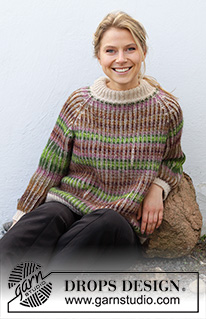
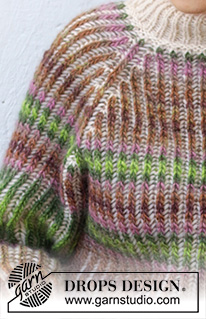













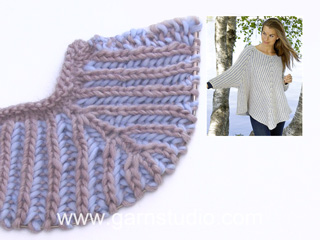
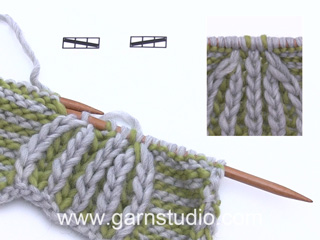




































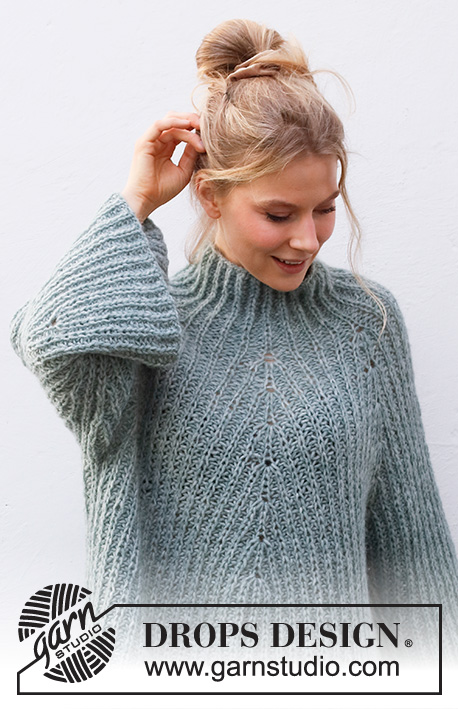
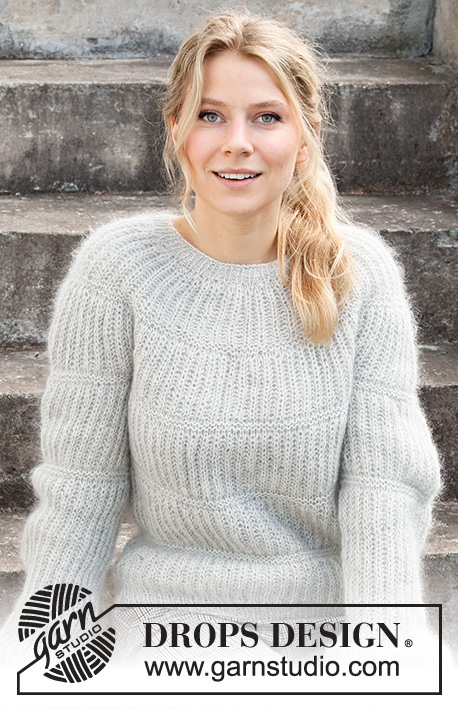






Comments / Questions (20)
For the yoke I have 80 stitches after my yarn over round. To place the markers that is only adding up to 76 stitches. What am I doing wrong?
27.01.2024 - 00:18DROPS Design answered:
Hi Cate, The markers are inserted in the next stitch, not before the next stitch, which accounts for your 4 missing stitches. Happy knitting!
29.01.2024 - 06:42I love the Metamorphosis sweater and have started to knit it. But I cannot get further than the second row of A1 on the yoke because i seem to lose the yarnover stitches at the ends of the needle and cannot work out how to correct it. Please can you advise me what I am doing wrong? I have knit flat Fishermans Rib before, but this is quite different. I am so frustrated because I want to get on with it and watch the pattern grow.
07.03.2023 - 20:59DROPS Design answered:
Dear Debra, this video shows how to work English rib in the round with 2 colours - it might help you to visualize the transition between rounds. Happy knitting!
08.03.2023 - 09:14This looks like Dancing Aurora 218-26 How are they different?
22.11.2022 - 15:48DROPS Design answered:
Dear Elle, the right side rows are not the same in these both patterns, here you have the knitted stitches of the English rib worked in Big delight in the other pattern, they are worked with Air. Happy knitting!
22.11.2022 - 16:12Bonjour, le fils big delight n'étant plus disponible, par quoi pouvons nous le remplacer ? Cordialement
20.09.2022 - 09:38DROPS Design answered:
Bonjour Sophie, vous pouvez utiliser par exemple une autre laine du groupe C ou bien 2 fils du groupe A comme Fabel ou Delight (pour conserver l'effet dégradé) + une autre laine du groupe A, découvrez ici un mélange Delight-Kid-Silk, votre magasin saura vous conseiller les couleurs assorties si besoin, même par mail ou téléphone. Bon tricot!
20.09.2022 - 10:13I live in Canada, and I would like to order the wool for the Metamorphosis #119 or Divergence # 274 pattern . I am a size large. Could you shipped to Canada? Thanks for your help. Your patterns are very nice. Best regards, Pam
01.06.2022 - 15:25DROPS Design answered:
Dear Pam, you will find the list of DROPS Stores in/shipping to Canada here. Happy knitting!
01.06.2022 - 16:51Nå er jeg lettere frustrert. Jeg har begynt å strikke på denne genseren, og vært veldig fokusert på oppskrifte/mønsteret. Nå har jeg kommet et stykke, og holdt på i mange dager. Oppdager nå at oppskriften ikke gir meg denne genseren, men det er lik oppskrift som Dancing Aurora - og det jeg har strikket likner mer på den enn Metamorphosis!!!? Og når jeg sammenlikner oppskriftene så er de like? Så utrolig frustrerende! Hva har skjedd?
11.01.2022 - 22:24DROPS Design answered:
Hej Camilla, det er samme opskift men den ene er med den ene side som retside, og den anden er med den anden side som retside. Vi skriver i opskriften: Arbeidet vrenges når det er strikket ferdig (før montering), slik at Big Delight blir synlig på rettsiden. God fornøjelse!
17.01.2022 - 13:40I can't find the colour 06 Autumn Forest in Big Delight in stores in the UK. Has it been discontinued?
30.09.2021 - 23:35DROPS Design answered:
Dear Mrs Evzans, correct, you can replace DROPS Big Delight with 1 strand Delight + 1 strand another yarn group A - try out our yarn converter - read morea bout alternatives here your DROPS store will help you choosing the best matching alternative. Happy knitting!
01.10.2021 - 07:45Ik brei model 215-22. Ik heb opgemerkt dat het stekenpatroon hetzelfde is als van model 218-26, nochtans zien beide modellen er niet hetzelfde uit. Ik bekom ribben zoals bij model 218-26. Ook wordt mijn breiwerk hierdoor te smal, wat doe ik fout?
11.08.2021 - 12:02DROPS Design answered:
Dag Lieve,
Het stekenpatroon is inderdaad exact hetzelfde, alleen wordt deze trui aan het einde binnenstebuiten gekeerd, zodat Big Delight meer zichtbaar is. Wat betreft de afmetingen: heb je een proeflapje gemaakt om de stekenverhouding te controleren? Pas eventueel de naalddikte aan voor een juiste stekenverhouding.
17.08.2021 - 12:56Ik brei model 215-22, en ik heb gemerkt dat het stekenpatroon hetzelfde is als bij 218-16. Ik bekom het resultaat van 218-16 ipv 215-22 en mijn breiwerk is te smal. Wat doe ik fout?
07.08.2021 - 15:05Ik vraag me af of het aantal gram wel voldoende is voor deze trui. Het lijkt me zo weinig. Dit mede omdat ik zie dat herfstbos bijna niet meer beschikbaar is.
21.02.2021 - 19:54DROPS Design answered:
Dag Mathilde,
De hoeveelheden zouden moeten kloppen. DROPS Air is heel licht in gewicht; vandaar dat je minder in grammen nodig hebt. Daarnaast gebruik je 2 verschillende garens.
23.02.2021 - 12:52